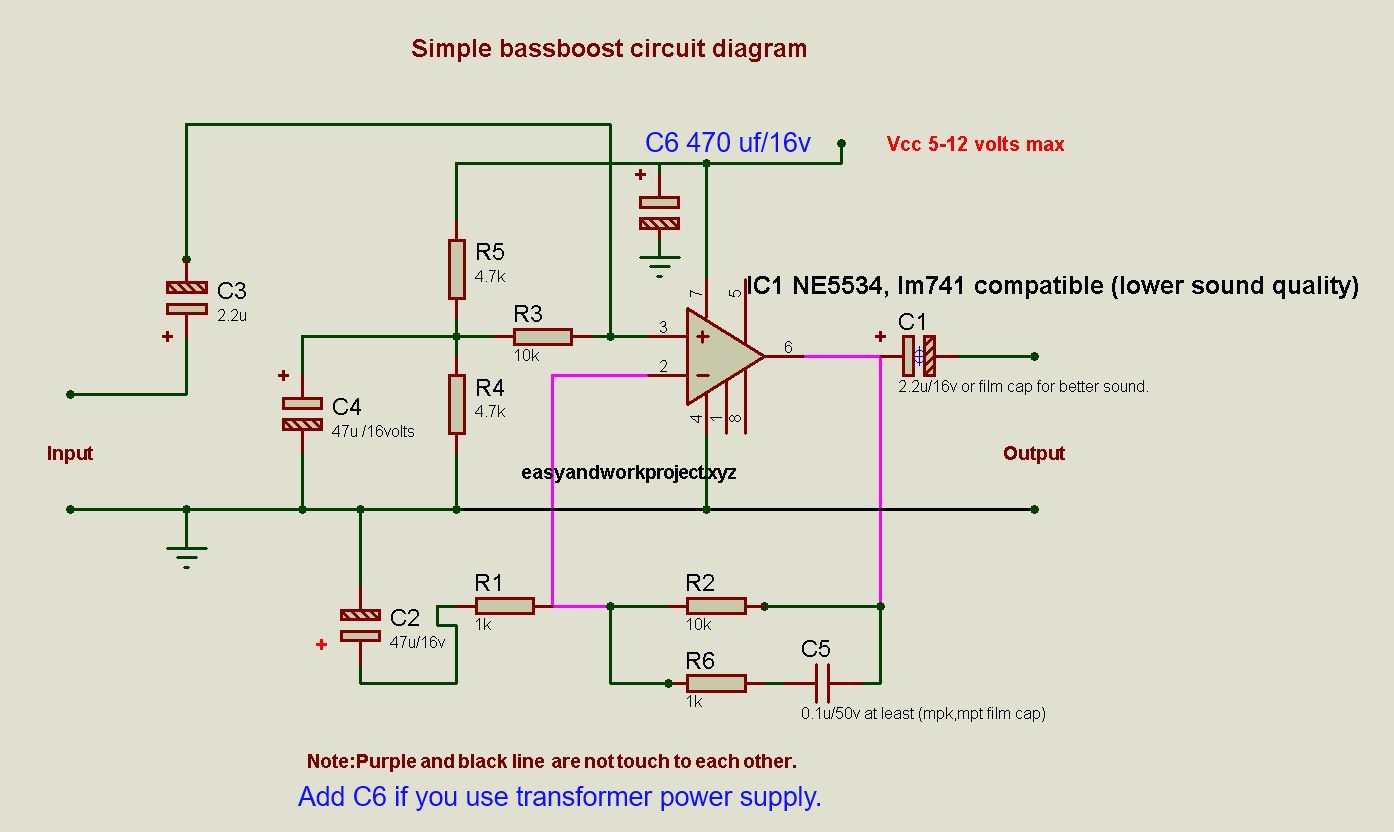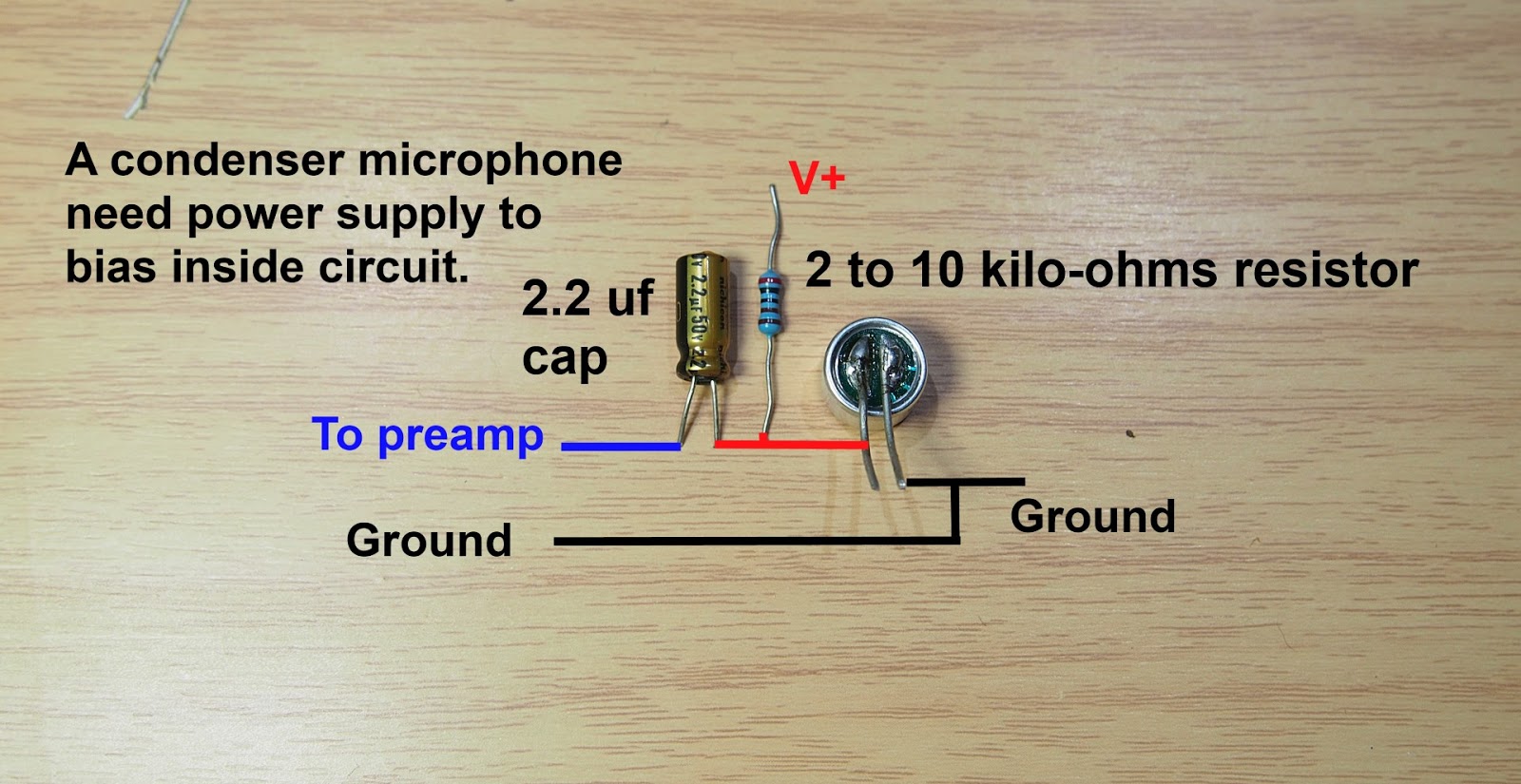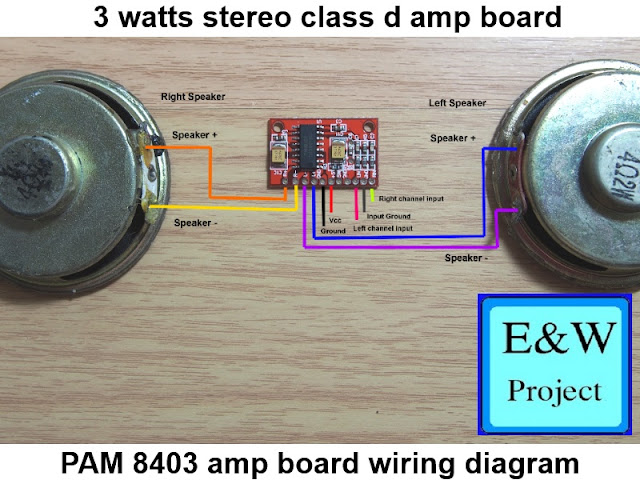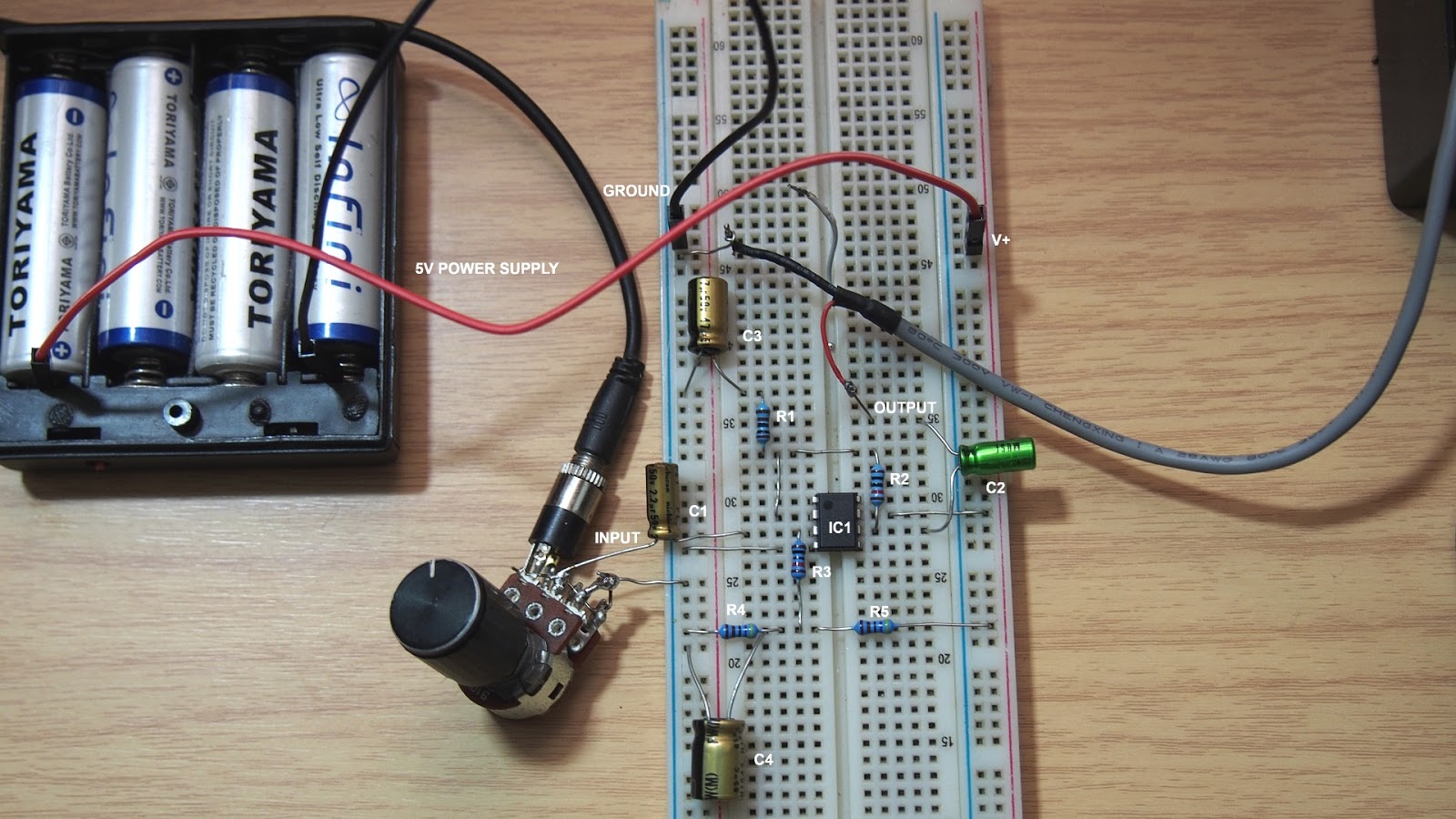How to add power supply filter capacitor to amplifier board.
I saw a new comment on my video, he asked me how to add a filter capacitor to amplifier board D.C. power supply. I think it's a good question so I will explain it here.
What is a power supply filter capacitor?
It is the capacitor that used to filter AC ripple from DC power supply present to amplifier board. If an amplifier has low capacitive power supply capacitor, it may present a little hum(50/60 Hz low-frequency sound) that you can hear in a quiet room.
The capacitor also stores power and bring it instantly to your amplifier when an amplifier needs more power for a short period of time such as explosion sound in a movie.
However, If an amplifier has high-frequency power supply noise from a switching power supply, small capacitor need to parallel to a power supply and must be attached close to power amplifier IC as much as possible.
Below pictures are the place that you add power supply capacitor.
 |
PAM 8610 board amplifier power supply sign
Caution!! an electrolytic capacitor has polarity. DO NOT REVERSE BECAUSE IT CAN WILL EXPLODE OR CAUSE A FIRE!!!
Note: The 100 uf capacitor that attach to pam 8610 is used to supply instant peak current to the board, you need to have at least 2200 uf smoothing capacitor connect to your power supply!! but it not necessary to attach to the amplifier board.
An image below shows capacitor polarity.
 Below is the formula for DC smoothing capacitor C = I x t/ΔV C = capacitance in Farad (multiply 1,000,000 and you get uf value) I = power supply ampere t = time that capacitor supply current to load for 1/2 cycle (8.3 ms for 60 Hz and 10 ms for 50 Hz 220 volts line) ΔV = voltage drop while current flowing out from capacitor example: pam 8403 give 6.4 watts power @ 4 ohms that mean it consumes around 1.78 Amps peak at full power (add 10% for any lost in amplifier)so, I =2 amps t 0.008 for 60 Hz AC line ΔV = maximum voltage drop when current flow from capacitor to load = 1 volt max C = 2 x 0.008 / 1 C = 0.016 Farad Convert to uf = 0.016 x 1000000 C = 16,000 uf and that makes the caps bigger than amp board and you don't need it because in real life you don't need full clean DC for Pam 8403 to operate, you just need 1 / 10 for instant transient peak music and around 1000 -2200 uf for the AC power supply(the big cap doesn't need to attach to amplifier board) See more tutorial. HOW TO MAKE A DC POWER SUPPLY FOR YOUR AMPLIFIEREnjoy electronic hobby with EASYANDWORKPROJECT.XYZ |









thanks for clear explanation
ReplyDeleteYou're welcome.
DeleteI have D-amplifier that whenever I touch the volume knob it produces hum. Will this be helped by capacitor on powerinput?, aluminum casing? thanks
ReplyDeleteTry ground potentiometer case to ground and see the result :D
DeleteThanks, that was the problem....
ReplyDelete❓CAN I REPLACE SMD CAPACITORS FROM PAM8403 AMPLIFIER BOARD❓ SUDDENLY IT NOT WORKING, BUT IC GETTING HOT AFTER POWER CONNECT.... PLEASE ANSWER...
ReplyDeleteYes you can do it.
DeleteHello!
ReplyDeleteCan i solder power supply cap downside the pcb board?
Thank you!
Sure!!!
DeleteThank you!
DeleteThe first small caps near amp input they are decoupling caps?
in my version they are 1uf
I changed them to Vishay Ero 1818 mkt 1uf 63v
i tried with supply cap and its working very nice
ReplyDeletenothing- completly black background. But i soldered 6800 uf cap
I think its ok with this big cap for power supply?
Thanks a lot!
It's ok to use 6800 uf cap for power supply. The bigger cap the better smooth DC current.
DeleteNo, I think decoupling- they are first to power input (first to the speakers terminal)
ReplyDeleteSo, tell me Phethai abot small 1 uf caps please... :)
Regards!!!!
Did you mean 1 uf from TA2024 or pam8610 board?
DeleteThank you Phethai for feedback
ReplyDeleteI mean front 1uf or in some versions bipolar elna blue 2.2uf caps at the front of ta2024
close to the pin's input.
This big cap working fine! But i wanted to be sure, and I also trust in your electro-wisdom.
It's a Coupling Capacitor, it block any DC from input audio source( mobile phones,DVD player may have small DC leakage and that may make the TA2024 IC malfunction).
DeleteThe capacitor parallel with a big red film cap(for each channel), I think it not necessary to the circuit and can be removed but low frequency respond may decrease a little bit, you can change big film cap from 1 uf to 2.2 uf high quality film capacitor and remove the capacitor for better sound quality (input capacitor affect sound quality significantly).
Thank you for your compliment ;)
Hi again,
ReplyDeleteI have to do something with cap's I guess. Or maybe it's because of swithing power supply. Or my speakers, I have full range like Fostex.
They are very sensitive. I think they are better for tube amp.
You know what? This TA2024 soun's amazing, for price- it's really the best of the best. But I want to do something with high frequencies.
Amp is really neutral, with amazing presention of instrument's on stage, but one thing- there is something harshy in high's, like in for example harpsichord bandwidth. It's not natural- you say- aha, It's digital amp, That's wy.
What do you think, It's good to looking for cap's and test it, or maybe give him linear power from toroid. For now i just replaced coupling cap's in input for Vishay Ero mkt 1818 1uf. Soon, I will replace Audiophiller's for Clarity Cap's or Mundorf.
Thank you for your advice's, I have to check also with removed caps as you said.
Thank you
Linear power supply is a good upgrade because high frequency switching noise from switching power supply may cause harsh high frequency and you also need to keep every wire as short as possible and keep power supply wire away from speaker wire.
DeleteHi Phethai
DeleteCan you tell me something about bypassing caps, electrolytic larger caps by little mkp or mkt?
For what theoretically? And what happens after bypassing with sound in your opinion.
Can i add 1uf mkt cap's to the buffering 470uf cap's?
Bypassing capacitor is a small and low esr capacitor, it normally place as close as possible to IC Vcc pin.
DeleteThe film bypassing cap has lower esr than electrolytic capacitor that mean it can send out storage current bigger(for a very short period of time)than electrolytic capacitor and leave the rest to the big cap, it good for music that has a wide dynamic range.
I'm not sure the bypassing cap can make high frequency sound better significantly like an Input DC blocking capacitor, just low ESR ceramic capacitor can do the job well, but you can test it by trying different cap and test by yourself.
The other advantage of a small film bypassing capacitor is high frequency noise blocking, a capacitor act like a short circuit with high frequency
Example:
1 microfarad capacitor has impedance around 8 ohms @ 20,000 Hertz
but the impedance decrease to 1.59 ohms @ 100,000 Hertz, that mean high frequency noise have been bypass from power supply significantly.
or it's only good for bigger values capacitors more than 1000uf
ReplyDeleteAnd please, tell me again about role of capacitors in ta2024
ReplyDeletehttps://i.ytimg.com/vi/L9zHGMR5znM/maxresdefault.jpg
on the photo- from the left: small electrolytic's input capacitor's.
red Audiophiller's cap's i dont know what role, and last cap's at the right- power buffering cap's.
Thank you!
The red Audiophiller's cap parallel to input cap, replace it with high quality cap 2.2 uf value and remove both electrolytic input cap and the red Audiophiller capacitor( for each channel), you can hear the sound quality improve clearly if you use a good Mkp or Polystyrene film capacitor(try jensen 1 uf cap and test low frequency sound if low frequency is ok then use it).
DeleteThe ta2024 board has a built in ceramic cap (c6 ,c7) you don't need to add any small bypassing capacitor(but you can try it if you want), just change the c 18 and c 19 with audio grade low esr capacitor, In my experience Nichicon muse(audio) make sound bright, strong vocal and tight middle bass, not deep bass, mid to high frequency hard and details(you may not like it) good for jazz and concert ; Elna silmic II make mellow high, good vocal and flat deep bass and need long burn-in to pass dull high frequency, you may like the high frequency with this cap), you can try different capacitor if you have it in your spare part box :)
However, if you don't have big audio cap for C6,C7 you can try add small film capacitor and test the result, but I suggest you to replace them because on board capacitor(six of them) on TA2024 board(the picture you show) are low quality cap, SMD cap are acceptable.
Thank you for feedback. You are so kind and helpful.
DeleteHi Again!
DeleteHave you ever heard something about Biasing Op-Amps into Class A?
I've never tried it but I know it well. Op-Amps use complicate circuit and need strong negative feedback, If I do class A amp or pre amp I need to the amplifier that use simple circuit and use lowest global negative feedback.
DeleteI've made Sziklai pair class A single end amplifier( not pre amp)and it work very well, fast and live but some distortion still persist if increase volume, pair it with small speaker or high sensitivity speaker and play smooth music and you will forget push pull power amplifier, but bass respond is uncontrollable, not tight because of low negative feedback.
Hi! Long time no see
DeleteDo you think It's good idea to remove input cap's? It's gonna improve the sound qualiy?
I mean small electrolytic cap's 1uf or 2,2 bipolar elna in some versions of ta2024. Close to the pin input.
Thank you Phethai!
You can remove one input capacitor but you should leave film cap(red)in the circuit. Input capacitor prevent any DC current/voltage direct to input of the power amplifier.
DeleteSorry For Disturbing You Again. Ok Straight To The Noon Questions = Can I Use Regular Potentiometer For Volume Control On PAM➑➏➓ Amplifier Board? Cause I Have k & 100k Stereo Potentiometer. Suggestion s To Connect 1x➍ᙁ ➊➎watt, 1x➍ᙁ ➎watt & 1x➍ᙁ ➌watt Speakers At The Output Of PAM➑➏➓ Amplifier Board. I Really Need Some Suggestions.
ReplyDeleteYes, you can use any potentiometer, they are working the same.
DeleteI suggest you to use potentiometer that value less than 10 k because of noise issue may occur.
Do the speakers you ask me has a passive filter? If they are full range speakers, you must series them and the resistance may be around 12 ohms = safe for pam8610.
Hi,
ReplyDeleteI'm a little confused about the calculations for the PAM8403. According to the datasheet:
3W Output at 10% THD with a 4Ω Load and 5V Power Supply
but you are using 10W for your calculations. Consumes the PAM8403 as “end circuit” 7W more?
About the PAM8610: you are using a 100 uF cap. China module solutions are using a 2200 uF. Could you please explain me the pros and crons of both solutions?
Hello, PAM 8403 consume maximum 3 Watts per channel but the amplifier module has two channels(stereo) so total output power is 6 watts @ 10 % THD or around 8 watts when include lost in the PAM 8403 module so I choose 10 watts for safety margin for power supply.
DeleteNote: Ideal power supply should have infinity current.
Second answer. I add 100 uF cap to the amplifier module because the smoothing capacitor in chinese AC adapter not good as Elna(japan) so the 100 uf low esr cap will decrease ripple to the low quality AC adapter.
P.S. I add more define information to this page, thank you for your comment!!!
Deletehi,
ReplyDeletei have a power supply that powers a thread mill and it makes an awful low noise. I was wondering if you could help me lower down the sound. I think the motor speed controller {power supply} is not filtered. It's output is max 90 volts.
Normally, motor speed controller use pwm configuration to control duty cycle and it should have output cap.
DeleteHow much power of the thread mill motor?
If capacitor is not big enough, the output ripple current will make it explode.
oh, i forgot, what sort of filter cap do i buy?
ReplyDeleteHigh voltage and high current electronic circuit use electrolytic capacitor as a output filter.
DeleteWhich amp is best for sound bar. I have 6 nos 8ohm 8watt speaker. I want to use PAM 8610 or something else
ReplyDelete